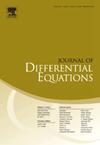To what extent does the consideration of positive total flux influence the dynamics of Keller–Segel-type models?
IF 2.3
2区 数学
Q1 MATHEMATICS
引用次数: 0
Abstract
Since the introduction of the Keller-Segel model in 1970 to describe chemotaxis (the interactions between cell distributions u and chemical distributions v), there has been a significant proliferation of research articles exploring various extensions and modifications of this model within the scientific community. From a technical standpoint, the totality of results concerning these variants are characterized by the assumption that the total flux, involving both distributions, of the model under consideration is zero. This research aims to present a novel perspective by focusing on models with a positive total flux. Specifically, by employing Robin-type boundary conditions for u and v, we seek to gain insights into the interactions between cells and their environment, uncovering important dynamics such as how variations in boundary conditions influence chemotactic behavior. In particular, the choice of the boundary conditions is motivated by real-world phenomena and by the fact that the related analysis reveals some interesting properties of the system.
Mathematically, or and we investigate Keller–Segel-type models with positive total flux , reading as(⊕) where , is a bounded and smooth domain, , and ν denoting the outward normal vector to the boundary of Ω, ∂Ω.
We aim at emphasizing how the inclusion of the incoming flowing flow makes the overall analysis more complex. The technical difficulties are essentially tied to the lack of the crucial property of the mass conservation, which in this case is replaced by an increase in the mass itself. Such behavior of the mass cannot be circumvented by merely including classical logistics of the form (with ); an additional dissipative term involving gradient nonlinearities is required. But there is another indication that suggests how the total positive flux significantly alters the dynamics of taxis models with zero-flux. Indeed:
- ◊for mechanisms with positive flux (), global (i.e. ) and bounded solutions are obtained as long as an essential strong logistic of the form () is included in the model;
- ◊for phenomena with zero flux (), analogies with the classical Keller–Segel models, without logistic, endowed with homogeneous Neumann boundary conditions, specially for blow-up scenarios (i.e., ), can be observed.
正总通量的考虑在多大程度上影响了keller - segel型模型的动力学?
自从1970年引入Keller-Segel模型来描述趋化性(细胞分布u和化学分布v之间的相互作用)以来,科学界已经有大量研究文章探索该模型的各种扩展和修改。从技术角度看,有关这些变式的全部结果的特点是假定所考虑的模型包括两种分布在内的总通量为零。本研究旨在通过关注总通量为正的模型,提出一个新的视角。具体而言,通过采用u和v的罗宾型边界条件,我们试图深入了解细胞与其环境之间的相互作用,揭示重要的动力学,例如边界条件的变化如何影响趋化行为。特别是,边界条件的选择是由现实世界的现象和相关分析揭示了系统的一些有趣性质这一事实所激发的。在数学上,或h,χ>;0和α∈(0,1),我们研究了总通量为正的keler - segal型模型uν−χuvν=χα αhuv,表示为(⊕){ut=Δu−χ∇·(u∇v)inΩ×(0,Tmax),τvt=Δv−v+uinΩ×(0,Tmax),uν=(α−1)χhuv,vν=−hvon∂Ω×(0,Tmax),其中Ω∧Rn, n≥1是一个有界光滑域,τ∈{0,1},Tmax>0, ν表示到Ω,∂Ω边界的向外法向量。我们的目的是强调如何包括传入流动流使整体分析更加复杂。技术上的困难基本上与缺乏质量守恒的关键性质有关,在这种情况下,质量守恒被质量本身的增加所取代。质量的这种行为不能仅仅通过包含au−bu2 (with a,b>0)形式的经典逻辑来回避;需要一个涉及梯度非线性的附加耗散项。但还有另一个迹象表明,总正通量如何显著改变零通量的士模型的动力学。事实上:对于具有正通量(α>0)的机制,只要在模型中包含au−bu2−c|∇u|2 (a,b,c>0)形式的本质强逻辑,就可以得到全局(即Tmax=∞)和有界解;-对于零通量(α=0)的现象,可以观察到与经典Keller-Segel模型的类比,没有逻辑,赋予齐次诺伊曼边界条件,特别是对于爆炸场景(即Tmax<;∞)。
本文章由计算机程序翻译,如有差异,请以英文原文为准。
求助全文
约1分钟内获得全文
求助全文
来源期刊
CiteScore
4.40
自引率
8.30%
发文量
543
审稿时长
9 months
期刊介绍:
The Journal of Differential Equations is concerned with the theory and the application of differential equations. The articles published are addressed not only to mathematicians but also to those engineers, physicists, and other scientists for whom differential equations are valuable research tools.
Research Areas Include:
• Mathematical control theory
• Ordinary differential equations
• Partial differential equations
• Stochastic differential equations
• Topological dynamics
• Related topics

 求助内容:
求助内容: 应助结果提醒方式:
应助结果提醒方式:


